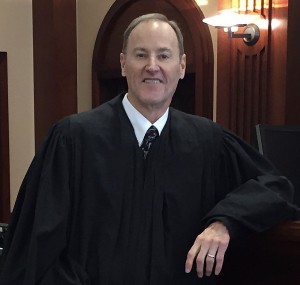Howard Tallman, a U.S. bankruptcy judge in Denver for the past 14 years, has hung up his robes for good.
Tallman, 66, has been working Colorado bankruptcy cases since the 1980s, rising from an assistant in a pilot trial that would become the U.S. Trustee program, to a role overseeing bankruptcies in three states. He joined the bankruptcy bench in 2002 and retired Jan. 3.
“Bankruptcy is about solutions,” said Tallman, who spent half his time on the bankruptcy court as its chief judge. “It sort of boils down to the fact that bankruptcy is an economic recycling machine for our economy.”
Tallman’s legacy includes tossing out a pair of business bankruptcies involving the sale of marijuana and, more recently, sorting through a wave of energy industry bankruptcies in the midst of an oil price slump.
In 2012, Tallman denied the bankruptcy petition of a party supply store in Denver that leased warehouse space to a marijuana grow, saying the court could not administer the case without committing a federal crime.
In 2014, he dismissed the individual bankruptcy petition of a marijuana wholesaler and distributer, saying the trustee would be breaking federal law by selling the man’s marijuana plants in the course of liquidating his assets.
Tallman first arrived in Colorado to attend law school at the University of Denver, graduating in 1975.
In 1982, he joined a U.S. Department of Justice trial program meant to separate the administrative role of bankruptcy trustees from the responsibilities of judges settling disputes among creditors and debtors. It would later become formalized as the U.S. Trustee program.
Tallman then jumped into private practice, first at Holland & Hart in 1986, then at Block Markus & Williams (now Markus Williams Young & Zimmermann) in 1995. He also worked as a Chapter 7 trustee.
Then, in 2000, Tallman returned to the program where he started his bankruptcy career. This time, he was the U.S. Trustee overseeing the administration of every case in Colorado, Utah and Wyoming.
“I came back as the boss for my region,” he said.
When he took office as U.S. Trustee, Tallman had more than 56,000 pending bankruptcies on his desk. “By becoming a judge” on the bankruptcy court, he said, “my caseload went down.”
Tallman hasn’t settled on retirement plans, but said he hopes to spend more time with his grandson and on the golf green.
“I looked at a judgeship as a capstone to my legal career,” he said. “I feel it’s time to let someone else have a chance to have as much fun as I had.”
Tallman’s position on the bankruptcy court has not yet been filled.
Howard Tallman, a U.S. bankruptcy judge in Denver for the past 14 years, has hung up his robes for good.
Tallman, 66, has been working Colorado bankruptcy cases since the 1980s, rising from an assistant in a pilot trial that would become the U.S. Trustee program, to a role overseeing bankruptcies in three states. He joined the bankruptcy bench in 2002 and retired Jan. 3.
“Bankruptcy is about solutions,” said Tallman, who spent half his time on the bankruptcy court as its chief judge. “It sort of boils down to the fact that bankruptcy is an economic recycling machine for our economy.”
Tallman’s legacy includes tossing out a pair of business bankruptcies involving the sale of marijuana and, more recently, sorting through a wave of energy industry bankruptcies in the midst of an oil price slump.
In 2012, Tallman denied the bankruptcy petition of a party supply store in Denver that leased warehouse space to a marijuana grow, saying the court could not administer the case without committing a federal crime.
In 2014, he dismissed the individual bankruptcy petition of a marijuana wholesaler and distributer, saying the trustee would be breaking federal law by selling the man’s marijuana plants in the course of liquidating his assets.
Tallman first arrived in Colorado to attend law school at the University of Denver, graduating in 1975.
In 1982, he joined a U.S. Department of Justice trial program meant to separate the administrative role of bankruptcy trustees from the responsibilities of judges settling disputes among creditors and debtors. It would later become formalized as the U.S. Trustee program.
Tallman then jumped into private practice, first at Holland & Hart in 1986, then at Block Markus & Williams (now Markus Williams Young & Zimmermann) in 1995. He also worked as a Chapter 7 trustee.
Then, in 2000, Tallman returned to the program where he started his bankruptcy career. This time, he was the U.S. Trustee overseeing the administration of every case in Colorado, Utah and Wyoming.
“I came back as the boss for my region,” he said.
When he took office as U.S. Trustee, Tallman had more than 56,000 pending bankruptcies on his desk. “By becoming a judge” on the bankruptcy court, he said, “my caseload went down.”
Tallman hasn’t settled on retirement plans, but said he hopes to spend more time with his grandson and on the golf green.
“I looked at a judgeship as a capstone to my legal career,” he said. “I feel it’s time to let someone else have a chance to have as much fun as I had.”
Tallman’s position on the bankruptcy court has not yet been filled.


Leave a Reply